From Images to Words
Pictures generate talk, a fact well appreciated by all teachers. This short post hopes to review some well known ideas as well as give you some new ones on using images to develop your students’ oral skills and foster communicative interaction in your lessons. The activities can be adapted to suit a variety of levels and can also be used for oral interview practice for those exams that require this. There are many activities in ELT methodology books to get students talking. Most of them involve creating an information gap between player A and B in a pair or amongst the members of a group. Here are a few you may already know of and may have used in your classes:
- ‘Describe & Find the Differences’ with images which are very similar but also have a number of differences or ‘Describe & Find the Similarities’ – an activity somewhat easier and more suited to younger pupils
Hhere is an An example from our school files :
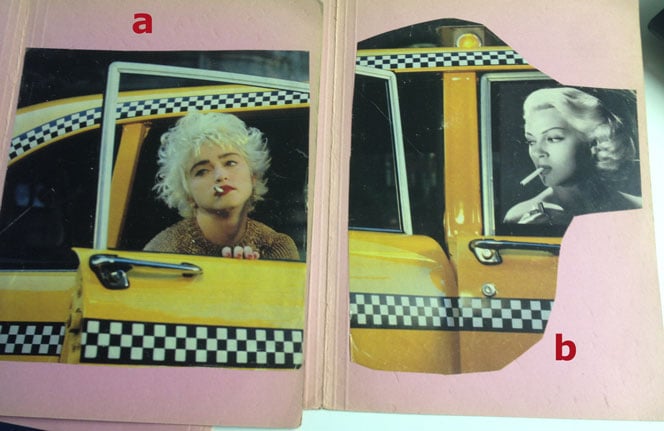
Sample folders A & B
DO NOT OPEN THIS FOLDER UNTIL YOU HAVE READ THE INSTRUCTIONS BELOW
F I N D T H E D I F F E R E N C E S
PLAYER A
- Without opening then, take one folder yourself and give the other one to your partner.
- There is one picture in each folder. The pictures are similar but not identical.
- Talk about your pictures until you have found as many differences as you can within the time you are given
- DO NOT LOOK AT YOUR PARTNER’S PICTURE AND DO NOT SHOW THEM YOURS!
- When the time is up, compare your pictures and discuss any difficulties you had finding the differences‘Describe & Find the Similarities’ – an activity somewhat easier and more suited to younger pupils
Instructions printed outside folder for student A (who leads the activity)
- ‘Find the pairs’ in which a number of images are the same and in the same positions
DO NOT OPEN THIS FOLDER UNTIL YOU HAVE READ THE INSTRUCTIONS BELOW
F I N D T H E P A I R S
PLAYER A
- Without opening then, take one folder yourself and give the other one to your partner.
- There are 6 pictures in each folder. 3 of your pictures are the same as your partner’s. The rest are different. The identical pictures are in the same position in each folder.
- Talk about your pictures until you are sure which ones are identical.
- DO NOT LOOK AT YOUR PARTNER’S PICTURE AND DO NOT SHOW THEM YOURS!
- When the time is up, compare your pictures and discuss any difficulties you had finding the differences
Instructions printed outside folder for student A (who leads the activity)
- ‘Find the Order’ where the teacher cuts up the images of a story in pictures, gives out one to each student in a group and asks them to describe, put in order and create a story
- ‘Describe & Arrange’ with player A receiving a number of images in a grid and player B getting the images cut up – player A describes the order to player B who must arrange them
- ‘Describe & Draw’ in which player A describes an image to player B who must draw it
DESCRIBE & DRAW
PLAYER A
- In the folder, you will find a picture. DO NOT SHOW IT TO PLAYER B.
- Tell player B that he must take a pencil, a rubber and some paper.
- Describe your picture to player B. Give him/her a general description of the picture first, then focus on detail.
- Tell then to draw what you describe.
- DO NOT WATCH PLAYER B WHILE DRAWING AND DO NOT GESTURE OR POINT.
- Tell player B that h/she can ask you questions and, if they do, answer them.
- When s/he has finished drawing, show your picture. Compare the two pictures and discuss any successes or difficulties and what language caused them.
N.B. Instructions sheets adapted from an old BC publication called ‘Take 5 (authors and date untraceable)
In this post, I would like to share four more and, hopefully, new to you activities, either using actual images using images in the minds of the learners.
Activity 1: Find your other half
I created this activity as finding similar images can sometimes take up a lot of time, but in this variation any image can be used if you can cut it up in half in any way which you think is suited to the image. Materials you need: Enough images for your class. These must be cut in half – I usually glue them in a small folder made of A4 or A3 paper, depending on the size of the image. Procedure:
- Students are given their half of an image and are allowed two or three minutes to think of how they would describe it – this is a good time for helping with words needed in case a learner asks, or with how to express a concept or talk about a shape or angle.
- Instruct the students to keep image hidden from view and to mingle in class describing their half, listening to other students’ descriptions.
- When they think they have found their match, they can show each other their images and if the same, they can sit down together and discuss any difficulties, or what clues, words expressions used by their partner helped them understand.
Here are some ideas of images that you could cut in half – across, down or diagonally – whichever best suits the image.
 Photo Credit: Maurice via Compfight
Photo Credit: Maurice via Compfight
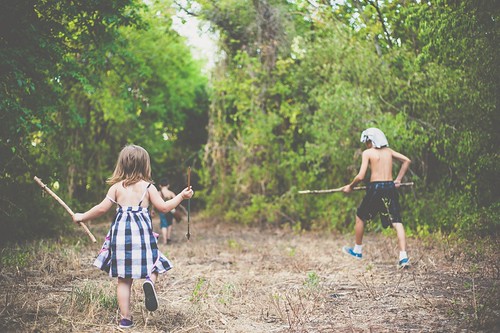
![]() Photo Credit: amanda tipton via Compfight
Photo Credit: amanda tipton via Compfight
Images selected can be a random collection or based on a theme, e.g. see last two above around a Christmas theme.
Here are a few samples we use in my school
Cover on everyone’s small folder with the half image & below two or three examples
Activity 2 – Pictures & Texts
Materials you need: Two photos or drawings, A & B, one of which should fit the description of an event, a person, place or object in a text your students are about to read or listen to. Procedure:
- Divide your students into A’s & B’s and give them each the relevant image.
- Ask students to describe their images to each other without showing them and to find as many differences or similarities they can within a set time limit.
- Take feedback at the end and allow them to look at each other’s image, discuss further differences or similarities, points of confusion.
- Ask them to guess which of the two images shows the right versions of the story or description they are about to read or listen to.
- Give out the text, without confirming, and ask them to read quickly and check which was the right image and how they know or where they found the information.
- Continue with further comprehension activities as usual
- As a follow up to the reading, you might ask them to use the image which was not the right one and rewrite the story or description with the information from that image.
An example
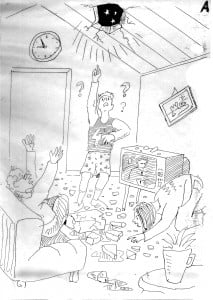 |
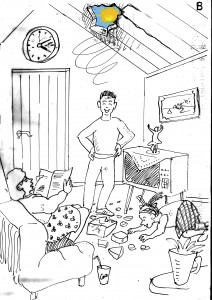 |
Images drawn by one of my past TEFL trainees, Soteroula Stoes.
And here is the text
Mystery Ice Smashes Roof |
| In America the strange case of the block of ice that smashed through the roof of a house in the small town of Timberville, Virginia, still defies explanation. It happened on 7 March 1976 as Wilbert Cullers, his son’s girlfriend were watching The Six Million Dollar Man on television. The local Daily News-Record reported what happened on that peaceful Sunday evening:”We heard a roar just like dynamite, and pieces of the ceiling came through,” Mr Cullers said. The pieces of ceiling and several large pieces of murky ice splattered onto the near the middle of the room, about a yard from the television.Several of the pieces bounced into the rooms adjoining the living room. When they looked up through the large hole in the living room ceiling, they could see all the way into the clear, star-speckled sky outside.” Where, then, had the ice come from? A question the Daily News-Record lost no time in putting to all available authorities. Dr.Lehman, an astronomer from the University of Virginia, and officials of the National Weather Service were found to be in agreement: the ice probably came from an aircraft. Dr.Lehman and his colleagues surmised that ice had formed at a broken water vent on a plane and had fallen off when it reached a weight of 10 or 15 lb (4.5-7 kg).Others, however, seemed to be less sure. Not only did local meteorologists say there was nothing in the atmosphere that night that could have caused a large block of ice to form on aircraft, but none of the people who were outside in the area of Wilbert Cullers’ house saw or heard an aircraft, although the night was clear. |
From Arthur C. Clarke’s Mysterious World (Collins)
Variation: If you have a text and a sequence of images that go with it, you can get the students to do a find the order activity, create and tell/write a story, then read the story or listen to it and compare with their own version.
Activity 3: Questions Please
This activity uses a number of images and, if you like, some word prompts, to get students to discover a story by asking questions. It was inspired by a similar activity in Listening in Action, a great book for listening activities by Michael Rost; in this variation, it can be used for listening or reading and language focused work. Materials you need: Some images which appear in a story you are going to narrate to the students or which you can ask them to read. Procedure:
- Show the images & words on the board or data projector
- Tell the class these are ideas from a story you are about to tell them but they have to discover it by asking you YES/NO questions.
- Divide Ss into groups and allow them time to brainstorm a number of questions inspired by the images
- Get the class to ask you their questions (and listen to other students’ questions and your answers)
- At the end of time you allow for their questions, put them back into their groups and ask them to reconstruct your story
- Groups report their stories – what they think happened
- You tell the actual story or students read it and compare with their own. The class decides which one closest to yours
- Do any other comprehension or language work you think is suited to your aims and level of the class
- At the end of this section, reform groups and ask them to create their own story and draw some images as clues for other groups
- Repeat the process: each group displays their images and answer only YES/NO questions
- Groups then try to reconstruct stories created by other groups
Example
And here is a simple text I sometimes use to review narrative tenses
| It was my birthday and at 8 o’clock I started getting ready for my birthday party. I had already laid the table and put out all the food and drinks. Then, I got in the bathtub and relaxed. I was singing happily when the phone rang. I stepped out of the tub quickly to run to the phone but unfortunately I slipped on a water puddle and fell down. Ouch! That hurt! I got up and picked up the phone, but by the time I had picked it up it was dead. I was going back to the bathroom, when the doorbell rang. I went to the door and opened it. A young man from the flower shop was there with a beautiful bunch of roses. I read the note. My friends at school had remembered my birthday! How wonderful! I ran back inside to put them in a vase but as I was unwrapping the flowers my cat got in the way, I tripped over it, fell down again and then a bee flew out of the flowers and stung me on the nose! By the time my friends arrived, I had already left for hospital, so there was no birthday party! |
Variation Instead of the simple clip art images which I have used, you can use the images in a picture story from a book or you can make a picture sequence with a tool like storybird The students look at the picture sequence and ask you as many YES/NO or even WH- questions as they wish to discover the events – then they recreated the narrative and finally read the original if you have one.
Activity 4: Musical Portraits
This activity exploits images in the mind of your students Materials you need: 2, 3 or more short musical pieces of different styles, jazz, heavy metal, etc. The music must be without words. Procedure:
- Without any other preamble, put the following headings on the board and ask your students to close their eyes and listen to the 2, 3 or more descriptions of different people and make a mental note (they can jot down their impressions later)
|
1 |
2 |
3 |
|
| NATIONALITY | |||
| APPEARANCE | |||
| PERSONALITY | |||
| JOB | |||
| HOBBIES | |||
| STAR SIGN |
(Add, change or take out any of the headings)
- Play the first musical piece and ask the students to take notes when done; hearing music instead of a description with words may come as a surprise to the students at first, but they usually catch on quite quickly. At the end, ask them if they could think of a person through the music, what they looked like and what sort pf person.
- Allow them to jot down their thoughts quickly.
- Do the same for the other musical pieces
- When done playing the recordings, ask the students in pairs or small groups to talk about their notes and to compare their descriptions with those of other students
- If you wish to develop this activity further, ask the students to imagine a meeting between two of these people, what happens and what they say to each other. You could jot down some questions on the board such as If these two people met… – Where would they meet? – How would they meet? – What would happen? – What would they say to each other? The students could also improvise the conversation these two people would have if they met
(I learnt this activity from Anji Malderez in a worskshop in Istanbul in 1992)
Images used in this way are excellent advance organisers and can stimulate the imagination and create powerful associations to help recall content and language. The activities also stimulate creative thinking or divergent production and you can use images to get your students to write their own narratives, improvise and dramatise scenes, write speech and thought bubbles, create their own photoplays and more! A picture may be worth a 1000 words but it can also generate them, so use the power of images to help your students produce language.
Where to find royalty free images
Follow Marisa’s board Royalty Free Images for Teachers on Pinterest.
Study with me – check out our Cambridge and other courses









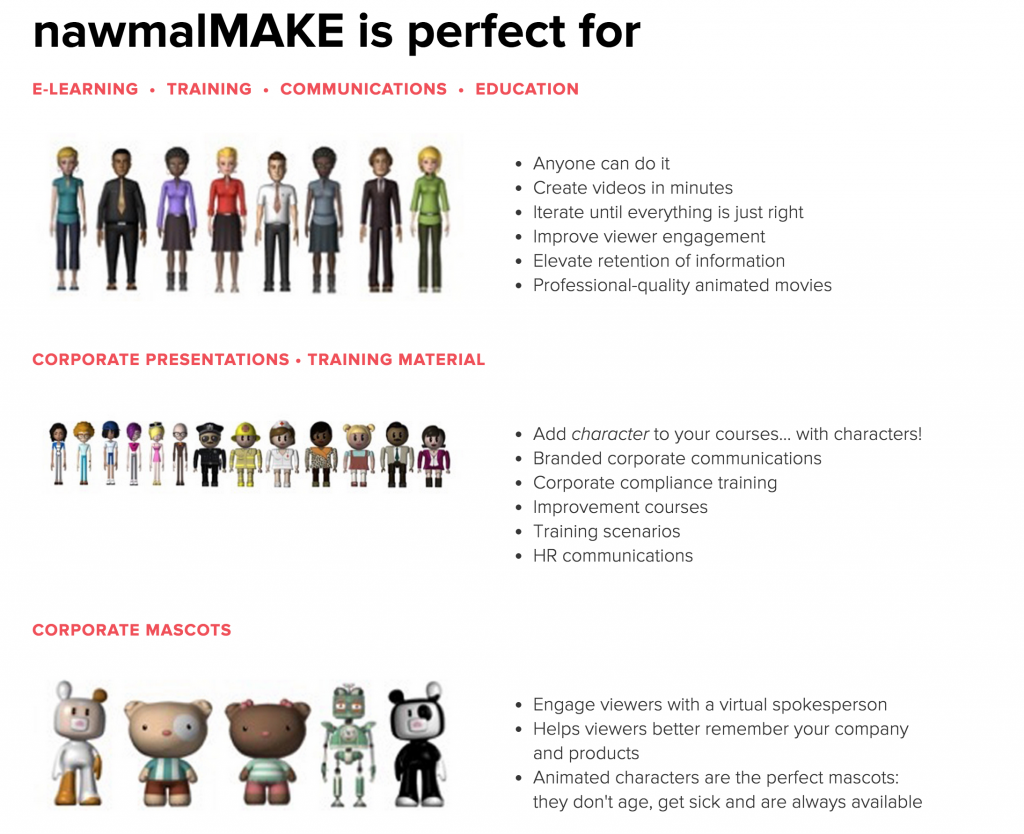
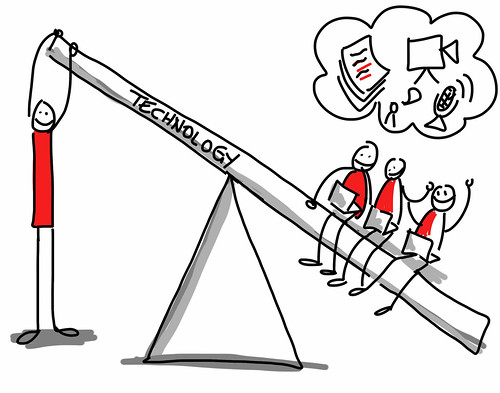
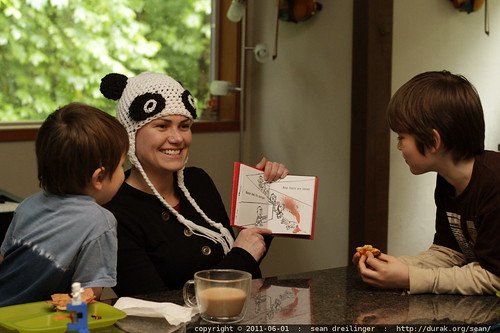
Leave a Reply